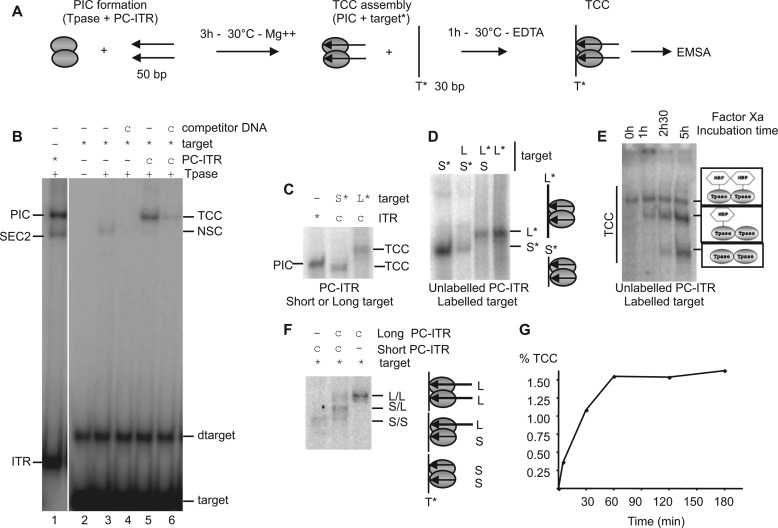FIGURE 1.
Organization of the Mos1 target capture complex. A, implemented protocol for TCC assembly. PIC was assembled with Tpase (gray ovals) and unlabeled PC-ITR (arrows) in catalytic conditions After assembly, labeled target (T*) was added with 5 mm EDTA to avoid strand transfer. TCCs were analyzed by EMSA. B, target capture assay. PIC assembly was monitored using labeled PC-ITRs (*) (lane 1). TCC assembly was monitored as described for A with labeled target (*) and unlabeled ITR (c) in the presence of transposase (+) (lane 5) and with competitor DNA (lane 6). The direct binding of MOS1 to the target was analyzed in the presence (+) or absence (−) of competitor DNA (lanes 3 and 4). Left side, complexes with labeled PC-ITR (SEC2, PIC). Right side, complexes with labeled targets (TCC and nonspecific binding complex (NSC)). Free DNAs (target, dimer of target (dtarget), and ITR) are indicated. C, PIC assembly was monitored using labeled PC-ITRs. TCC were performed with two labeled target: a short (S*) (30 bp) and a long target (L*) (50 bp), and analyzed by EMSA. D, determination of the number of target in the TCC. EMSAs were performed with short/long target combinations and a cold PC-ITR, as indicated. L, long target; S, short target. Labeled targets are indicated by asterisks. Targets present in the complexes are drawn on the right. E, determination of the number of transposase in TCC. For each condition, TCCs were assembled as described in A with labeled target (*), unlabeled ITR (c), and transposase. TCC assembly was performed without factor Xa treatment (0 h). After TCC assembly, TCCs were subjected to factor Xa cleavage for various times (1 h, 2 h 30 min, and 5 h) before EMSA. The proteins present in the various TCCs are drawn on the right. F, determination of the number of ITRs in the TCC. TCC assembly was performed with unlabeled (c) short (S)/long (L) ITR combinations and a labeled target (*) and analyzed by EMSA. The ITRs present in the complexes are drawn on the right. L/L, two long ITRs; S/L, one short and one long ITR; S/S, two short ITRs. G, kinetics of TCC formation. After PIC assembly as described in A, TCC formation was allowed to proceed for various times (0, 5, 30, 60, 120, and 180 min). The percentage of TCC formed was quantified (labeled target in TCC-labeled target in TCC + free target) and plotted as a function of time.

